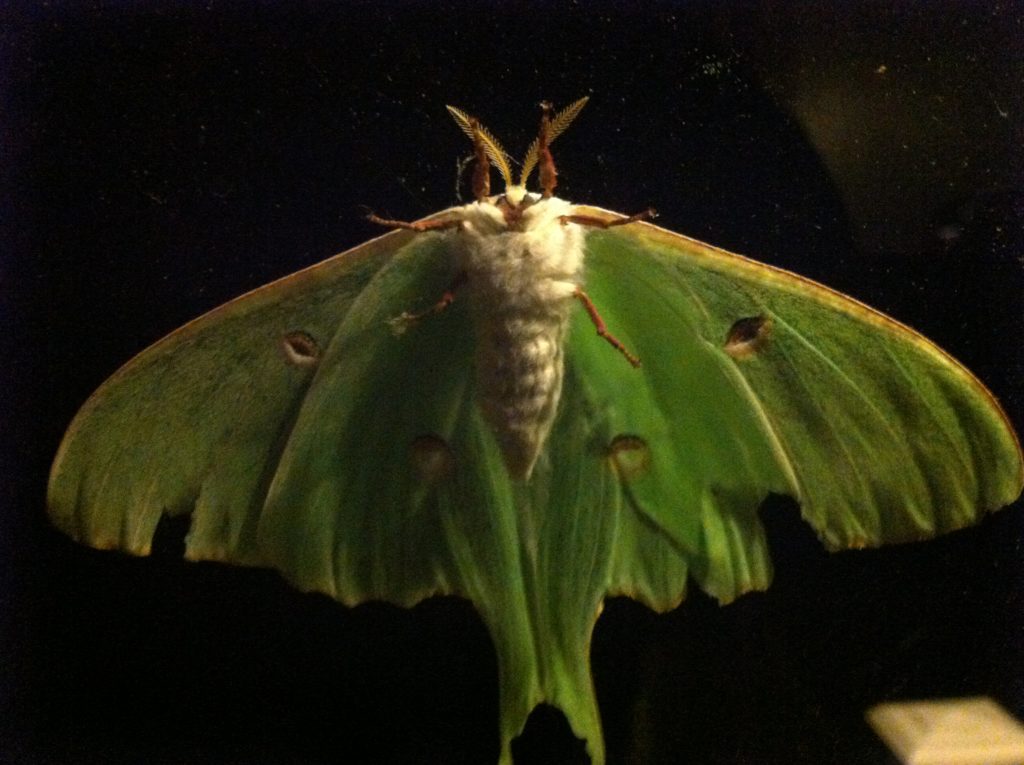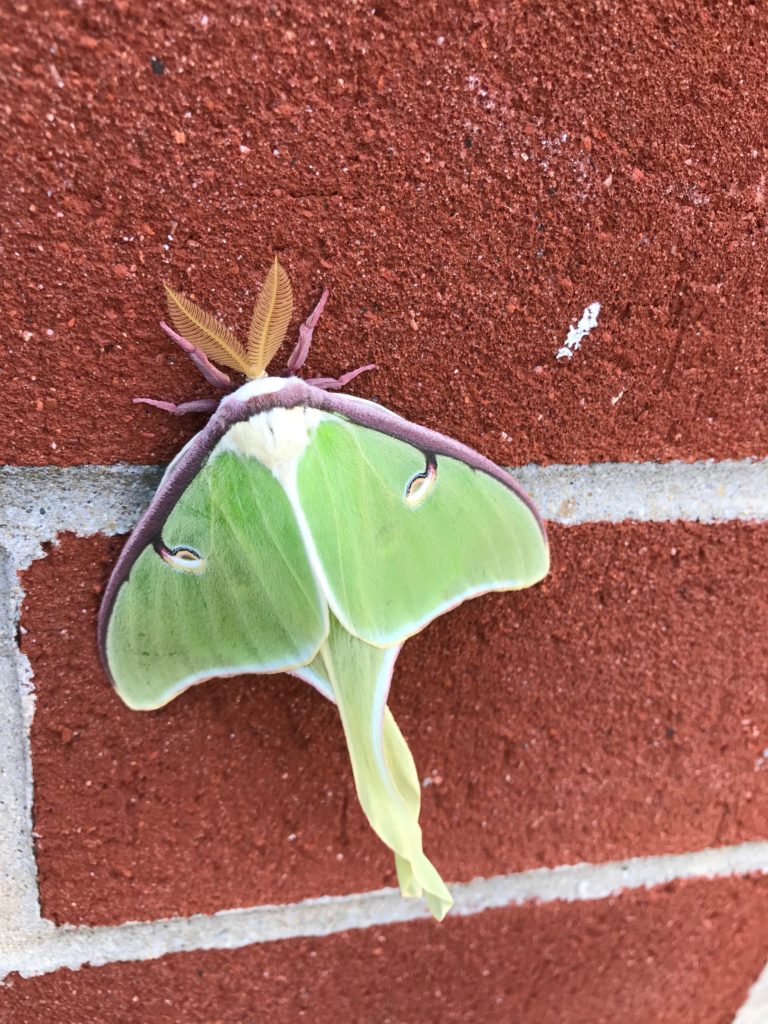Recently, a friend pointed out a creature clinging quietly on the bricks on the side of the fitness center at work. Although it was the middle of a summer day, the creature was a normally nocturnal Luna moth (Actias luna). This species was named because of its moon-like spots by the father of biological classification, Carolus Linnaeus himself, in 1758. The wings of Luna moths are pale green to bluish green with maroon or yellow rims, and with long tails swooping off the ends of the hind pair of wings. Both pairs of large wings have eyespots shaped a little like moons, that can be used to frighten predators. The hind-wing tails can also be used to confuse the echolocation of bats that swoop in to snag a moth out of the air and eat it.

This moth was photographed in an evening on a screen door. The friend sent the picture to me to find out what it might be. You can see the underside of the moth. You can also see that the wings are ragged, possibly from flying past vegetation or escaping predators.

This moth was about 5 ft off of the ground (about 1.5 meters) resting on a brick wall at about 11:30 AM. The hind wings are tucked under the forewings but the tails are very striking and you can see the maroon on the leading edge of the forewings. Sometimes that color goes around most of the wing edges.
Orienting Luna Moths in the Natural World
Insects are part of the kingdom Animalia, itself a part of the eukaryotes. The Eukaryote domain is a group of kingdoms whose members all have a membrane around a nucleus in their cells. Insects are the class in the phylum Arthropoda (“jointed foot”) which also includes other animals with exoskeletons such as lobsters and spiders. Phyla are subdivisions of kingdoms. Within the animal kingdom, insects are the class with the highest number of known species (about 900,000). In fact, insects account for more than half of all named eukaryotic species. Moths and butterflies are in an order of insects called the Lepidoptera (meaning “scale wing”). To give perspective, ants, wasps and bees are in a different insect order, the Hymenoptera (“membrane wing”) , and flies are in yet another order, the Diptera (“two-wing”). If you have ever accidentally brushed a moth or butterfly or seen one dead on the ground, you may have seen tiny powder-like scales coming off of the wings. This is the reason for the name of the group.
Inside the order Lepidoptera, the Luna moths are members of a family of large moths called the ”Saturniidae”, named after Saturnia, an alternative name for Juno, the Roman Queen of the Gods. There are 2,300 species in the Saturniidae but only 68 of these species live in North America. The species Actias luna, which I was seeing sitting on the red brick wall, is only found in North America. You might think that 2,300 is a large number of species to be in a family, but realize that there are 70,000 known species of weevils, a family in the beetle (Coleoptera or “case-wing”) order. For an insect family, Saturniidae isn’t very large.
Luna moths are in a subfamily of the saturniids referred to as the Giant Silkworm Moths. (The silkworm used to make silk is not actually in this family and is not native to North America but some of the Giant Silkworm Moths do make a small amount of silk).
How do Luna Moths Live?
With a wingspan of about 4.5 inches (around 11 centimeters), Lunas are one of the largest moths in North America. Some other saturniids are even larger. Luna moth caterpillars also get large large right before they form a pupa, and can eat a wide variety of plant leaves.
Two other large moths in the same subfamily are the Cecropia silkmoth (Hyalophora cecropia) and the Polyphemus moth (Antheraea polyphemus). Like the Luna moth, these two are large, nocturnal, and have caterpillars that feed on leaves of trees. They all find mates by coming out in the summer night, moving toward light, and using pheromones, or chemical attractants. Insects use pheromones as chemical signals for an array of activities including finding food, escaping predation and finding mates. Antennae of saturniids, especially males, are brushy and featherlike and are among the most sensitive chemical receptors to be found. Some moths have 60,000 receptors and can detect a single molecule of pheromone that has wafted from a mile away! Female Luna moths will release their pheromones and wait. Males will swim upwind until they find the source, often near midnight. Then pairs of Luna moths join, remain connected and mate for up to 24 hours. Later the female will lay several hundred eggs in small batches on vegetation. These eggs will hatch in a bout a week, and the caterpillars will be munching away on the leaves where they hatch.
Even More to Know!
There is a great deal more to say about the Luna moth and its relatives but I’ll just stick with a few more surprising features:
*Luna moth caterpillars hatch and grow quickly, molting several times and growing each time before forming a cocoon and inside it, the thin pupal covering.
* Luna moth caterpillars can rear up, spew a distasteful substance and make a clicking noise with their mouths to scare off predators
*Like other moths, Luna moths have a pupal stage when their body undergoes a dramatic metamorphosis. During that stage, the moth absorbs its entire digestive system and forms reproductive structures. As adults, Luna moths have tiny or absent mouths and never eat. They reproduce and die within about a week. Not all moths do this.
* Sometimes Luna moths have multiple generations in a summer. Later generations are colored slightly differently. As climate change occurs, multiple generations are occurring more northerly.
*Overall, large moths, including the Saturniidae, have declined in New England over the last 50 years. Luna moths, fortunately, appear to be holding steady, although they are not common.
NATIONAL MOTH WEEK!!! July 21-29, 2018
July 21-29 is National Moth Week! Who knew? You can be a part of something big by collecting data and submitting it to groups that want to know what moths are out there. Collecting information for scientists to use is a part of citizen science. In fact, moth week occurs in countries all over the world as well.
Believe it or not, looking for moths is called mothing. It is usually done at night.
If there is enough interest, I will try to arrange a local mothing event. You could also organize one! Get your family out on the lawn and use one of the fun techniques described here:
http://www.mothscount.org/uploads/How_to_start%20_mothing.pdf
Thanks to my friend for pointing out a delightful and amazing Luna moth. I hope you all get to see one as well some enchanted evening in the last week of July!
If you are interested:
Here is some information on National Moth Week
http://nationalmothweek.org/
Several of these moths can be seen if you navigate from here: https://www.butterfliesandmoths.org/taxonomy/Saturniidae.
Here is an interesting but somewhat technical paper about large-bodied moth declines in New England
http://nationalmothweek.org/wp-content/uploads/2012/07/Moth-Decline.pdf
more on insects:
https://www.si.edu/spotlight/buginfo/bugnos
